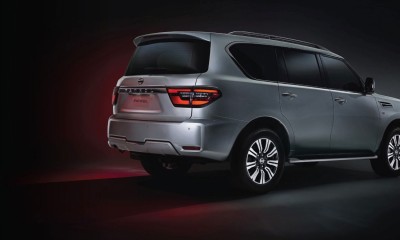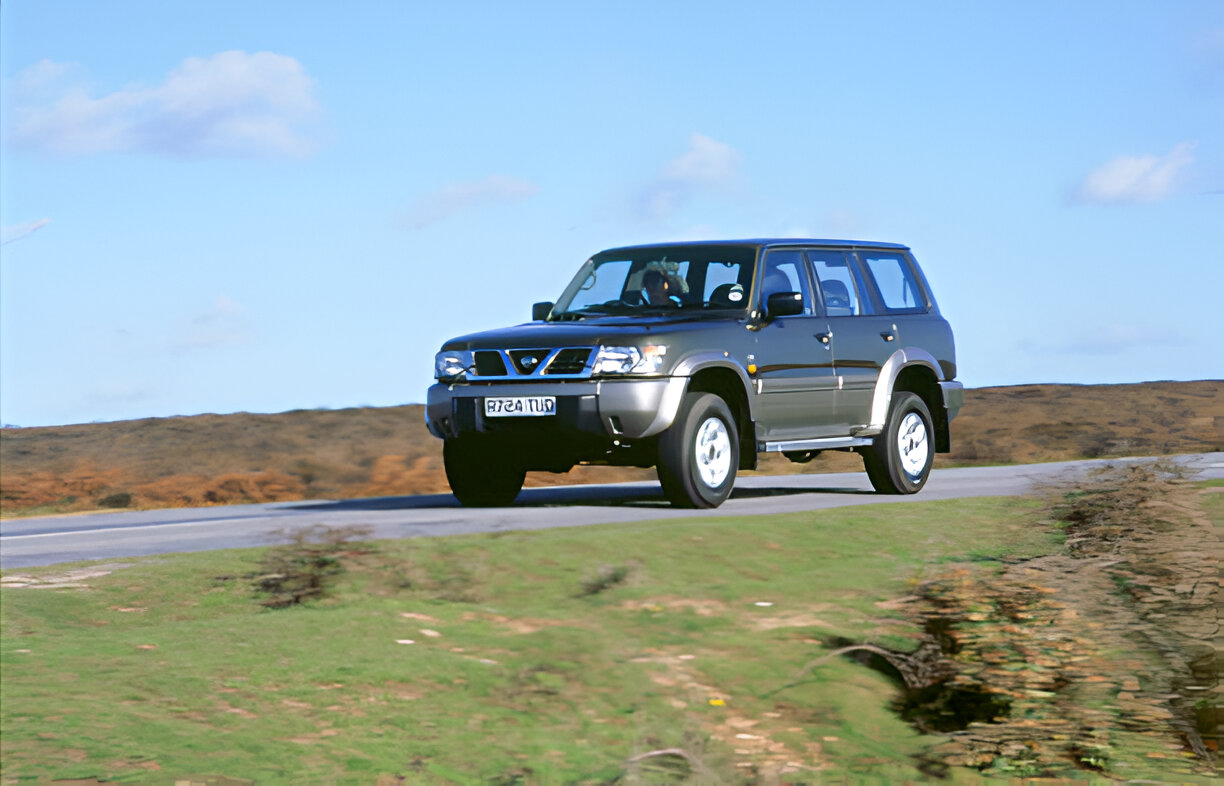Nissan Patrol 2024: An In-Depth Analysis of Specs & ECU Tuning Potential

The Nissan Patrol (Y62) stands as a monumental figure in the world of large SUVs. For decades, its name has been synonymous with rugged durability, off-road dominance, and, in its latest generation, a surprising level of luxury. This reputation, forged in the demanding terrains of Australia and the Middle East, is built on a foundation of robust engineering. In an automotive era defined by downsizing and forced induction, the 2024 Patrol remains a defiant testament to the appeal of large-displacement, naturally aspirated power. This engineering philosophy, which prioritizes reliability in extreme conditions over peak efficiency, results in a vehicle platform that is inherently "overbuilt." It is this significant engineering margin that makes the Y62 Patrol an exceptional candidate for professional performance tuning, offering a vast reservoir of untapped potential waiting to be unlocked. .jpg)
Core Powertrain Specifications: A Tale of Two Engines
The 2024 Patrol's global appeal is catered for by two distinct yet highly capable petrol engines. Each powertrain provides a different baseline for performance, reflecting the diverse demands of the markets it serves.
The 5.6L VK56VD V8: The Heart of the Legend
The flagship engine for the Patrol is the formidable VK56VD V8. This powerhouse is a key reason for the vehicle's legendary status, particularly for towing and high-performance applications.
-
Architecture: At its core is a 5,552cc (5.6L) V8 with a 32-valve, Dual Overhead Cam (DOHC) configuration. The engine block and cylinder heads are constructed from a lightweight and durable aluminum alloy.
-
Key Technologies: The VK56VD is equipped with two critical technologies that define its performance and tuning characteristics. Direct Injection Gasoline (DIG) provides precise fuel delivery directly into the combustion chamber for improved power and efficiency. This is complemented by Nissan's Variable Valve Event and Lift (VVEL) system, which continuously adjusts valve timing and lift to optimize performance across the entire rev range.
-
Performance Figures: From the factory, this engine produces a commanding 298 kW (approximately 400 hp) at 5800 rpm and 560 Nm of torque at 4000 rpm. To achieve these figures, it requires premium unleaded petrol with a rating of 95 RON or higher.
The 4.0L VQ40DE V6: The Versatile Workhorse
In certain markets, particularly the Middle East, the Patrol is offered with a proven 4.0L V6 engine. This engine is a member of Nissan's highly respected VQ series, known for its reliability and smooth power delivery.
-
Architecture: This DOHC V6 engine has a displacement of 3,954cc and benefits from the VQ family's all-aluminum construction and robust design principles.
-
Performance Figures: The VQ40DE engine delivers a solid 205 kW (approximately 275 hp) at 5600 rpm and 394 Nm of torque at 4000 rpm, providing ample capability for daily driving and moderate off-road use.
Transmission and Drivetrain Analysis
Power from either engine is managed by a sophisticated and robust drivetrain designed to handle everything from high-speed cruising to technical rock crawling.
-
Transmission: The Patrol is equipped with a Jatco JR711E/RE7R01B 7-speed automatic transmission. This unit features a manual shifting mode and Adaptive Shift Control (ASC), which adjusts shift patterns based on driving style and conditions.
-
Drivetrain: The formidable off-road capability is delivered through Nissan's Intelligent 4x4 system. It features an electronic shift switch allowing the driver to select between Auto, 4H, and 4L modes. This is further enhanced by a multi-terrain select system with modes for On-Road, Sand, Snow, and Rock. Critical off-road hardware includes an electronic rear differential lock, Hill Descent Control (HDC), and Hill Start Assist (HSA), ensuring maximum traction and control in challenging environments.
Table 1: 2024 Nissan Patrol Y62 Key Specifications (V8 vs. V6)
|
Specification |
5.6L V8 Model |
4.0L V6 Model |
|
Engine Code |
VK56VD |
VQ40DE |
|
Displacement |
5,552 cc |
3,954 cc |
|
Max Power |
298 kW (400 hp) |
205 kW (275 hp) |
|
Max Torque |
560 Nm |
394 Nm |
|
Fuel System |
Direct Injection Gasoline (DIG) |
Multipoint Fuel Injection |
|
Transmission |
7-Speed Automatic |
7-Speed Automatic |
|
Drive Type |
Intelligent 4x4 |
4WD |
|
Towing Capacity (Braked) |
3,500 kg |
2,000 kg |
|
Fuel Consumption (Combined) |
14.4 L/100km |
N/A (Market Dependent) |
Deconstructing the Factory ECU: The Key to Unlocking Performance
To understand the true tuning potential of the Nissan Patrol, one must first analyze its engine management system. The Engine Control Unit (ECU) is the sophisticated computer that governs every aspect of the engine's operation, and modifying its software is the key to unlocking significant performance gains.
The Brains of the Beast: The Patrol's Engine Management System
The Nissan Patrol Y62 platform utilizes advanced Engine Control Units, predominantly supplied by Hitachi. Specific models have been identified for both powertrains: the 5.6L V8 is often managed by Hitachi units like the DEA030-2xx or MEC78-XXX, while the 4.0L V6 uses controllers such as the BEM3F0-000. This ECU is responsible for orchestrating a complex set of parameters in real-time, including:
-
Fuel injection volume and timing
-
Ignition timing advance
-
VVEL system actuation
-
Electronic throttle control
-
Torque delivery and limiters
The Proactive vs. Reactive Tuning Paradigm
The fundamental difference between a factory tune and a professional remap lies in their operational philosophy. The stock Nissan ECU employs a highly intelligent but ultimately reactive tuning strategy. Its primary tool for optimization is an active knock control system. This system continuously advances ignition timing to the edge of what the engine can handle. When it detects the onset of engine knock (pre-detonation), it immediately retards the timing to a predetermined safe level. This means the engine is constantly "testing the boundaries" rather than operating from a state of proactive optimization.
In contrast, a professional ECU remap from a service like HP Chiptuningfiles is a proactive solution. The tuning file is meticulously calibrated for a specific, high-quality fuel (e.g., 98 RON). This allows for the implementation of optimized ignition and fuel maps that are designed to prevent knock from occurring under normal high-load conditions. The knock sensors are retained as a crucial safety system, but they are no longer the primary mechanism for performance mapping. This proactive approach delivers more consistent, reliable, and powerful performance.
 This reactive nature of the factory ECU has another important implication. If the system detects knock, perhaps from a bad batch of fuel or a temporary switch to a lower octane, it will default to a conservative "low-octane" map. Critically, it will remain on this safer, less powerful map until it has seen a consistent absence of knock over a prolonged period, which can be as long as one or two full tanks of high-octane fuel, or until the ECU is manually reset. This means a driver who refills with premium fuel may not experience premium performance immediately. A professional remap eliminates this latency by establishing the high-performance map as the default, ensuring consistent power delivery whenever the correct fuel is used.
This reactive nature of the factory ECU has another important implication. If the system detects knock, perhaps from a bad batch of fuel or a temporary switch to a lower octane, it will default to a conservative "low-octane" map. Critically, it will remain on this safer, less powerful map until it has seen a consistent absence of knock over a prolonged period, which can be as long as one or two full tanks of high-octane fuel, or until the ECU is manually reset. This means a driver who refills with premium fuel may not experience premium performance immediately. A professional remap eliminates this latency by establishing the high-performance map as the default, ensuring consistent power delivery whenever the correct fuel is used.
What is Professional ECU Remapping?
ECU remapping, also known as chiptuning, is the process of modifying the operating software within a vehicle's Engine Control Unit. The process typically involves these steps:
-
Reading: The original software file is read from the ECU, usually through the On-Board Diagnostics (OBD) port.
-
Modification: This file is then analyzed and modified by expert tuners using specialized software. Key parameters are adjusted to enhance performance.
-
Writing: The newly modified, performance-oriented file is written back onto the ECU.
The parameters adjusted during a professional remap include:
-
Ignition Timing Maps
-
Air-to-Fuel Ratio (AFR) Targets
-
Torque Limiters
-
Electronic Throttle Maps for improved response
-
VVEL Phasing and Cam Timing
-
Vehicle Speed and Engine RPM Limiters.
Tuning the 5.6L V8 (VK56VD): A Staged Approach to Dominance
The Patrol's 5.6L V8 is exceptionally responsive to tuning. A staged approach allows owners to choose a performance level that matches their goals and budget, from a simple software enhancement to a full forced-induction conversion.
Stage 1 Tuning: The Foundation of Power
A Stage 1 tune is the most cost-effective method for unlocking significant performance from the VK56VD engine, focusing almost exclusively on software optimization.
-
Objective: To achieve substantial gains in power, torque, and throttle response with minimal hardware changes.
-
Process: This involves applying a custom Stage 1 ECU remap from the HP Chiptuningfiles database, specifically calibrated for high-octane (98 RON) fuel. The tune optimizes the factory ignition and fueling parameters to deliver a safer, more powerful combustion process.
-
Hardware: While not strictly required, a high-flow drop-in air filter from a reputable brand is highly recommended to reduce intake restriction and allow the engine to breathe more freely.
-
Expected Gains: A well-developed Stage 1 tune typically yields an increase of +17 kW (23 hp) and +25 Nm of torque. This brings the total output to approximately 315 kW (422 hp) and 585 Nm. Beyond the numbers, drivers will notice a sharper throttle response and, in many cases, improved fuel economy during steady-state cruising.
Stage 2 Tuning: Enhancing Engine Respiration
For owners seeking to maximize the potential of the naturally aspirated V8, a Stage 2 upgrade is the definitive solution. This stage focuses on removing critical restrictions in the exhaust system.
-
Objective: To dramatically improve the engine's volumetric efficiency by allowing it to expel exhaust gases more freely.
-
Hardware: A full performance exhaust system is the cornerstone of a Stage 2 package.
-
Performance Headers: Also known as extractors, these replace the restrictive factory manifolds. A 4-into-1 long-tube design is optimal for scavenging exhaust gases and improving torque.
-
High-Flow Catalytic Converters: The stock catalytic converters, with a dense 400 Cells Per Square Inch (CPSI) matrix, are replaced with high-performance 100 or 200 CPSI units that significantly reduce backpressure.
-
Cat-Back Exhaust System: A larger-diameter (typically 3.5-inch) stainless steel cat-back system completes the package, further improving flow and delivering a more aggressive V8 exhaust note.
-
-
Process: The drastic change in airflow necessitates a dedicated Stage 2 ECU file. This file recalibrates the engine's fueling and timing to account for the reduced backpressure, ensuring optimal performance and safety.
-
Expected Gains: With the engine breathing freely, a Stage 2 tune elevates performance to approximately 330 kW (443 hp) and 610 Nm of torque. This represents a total gain of +32 kW (43 hp) and +50 Nm over the stock configuration.
Stage 3+ Tuning: The Realm of Forced Induction
The ultimate performance transformation for the Y62 Patrol is achieved through forced induction. The robust nature of the VK56VD engine makes it an excellent candidate for supercharging.
-
Objective: To deliver a monumental increase in horsepower and torque, transforming the Patrol into a true high-performance SUV.
-
Hardware:
-
Supercharger: The central component is a positive displacement supercharger kit, such as the Harrop FDFI-2300, which includes an integrated water-to-air intercooler to manage charge temperatures.
-
Fuel System Upgrade: This is a critical and non-negotiable requirement. The factory direct injection fuel pump is only sufficient for up to about 375 kW. A high-flow DI fuel pump module is essential to provide the fuel volume needed to support the increased airflow from the supercharger.
-
-
Process: A bespoke Stage 3+ ECU calibration is required to manage the complex parameters of a forced induction system, including boost control, larger fuel flow requirements, and revised ignition timing maps under boost.
-
Expected Gains: A supercharged Y62 Patrol is capable of producing staggering figures, with outputs reaching 430 kW (577 hp) and 725 Nm of torque.
Table 2: Nissan Patrol 5.6L V8 (VK56VD) Tuning Stages & Performance Gains
|
Tuning Stage |
Required Hardware |
HP Chiptuningfiles Solution |
Est. Power Output |
Est. Torque Output |
Gain vs. Stock |
|
Stock |
None |
N/A |
298 kW |
560 Nm |
N/A |
|
Stage 1 |
High-Flow Air Filter |
Stage 1 ECU Remap |
~315 kW |
~585 Nm |
+17 kW / +25 Nm |
|
Stage 2 |
Full Exhaust System (Headers, High-Flow Cats, Cat-Back) |
Stage 2 ECU Remap |
~330 kW |
~610 Nm |
+32 kW / +50 Nm |
|
Stage 3 |
Supercharger Kit, Upgraded Fuel System, Full Exhaust |
Stage 3 Custom ECU Remap |
~430 kW |
~725 Nm |
+132 kW / +165 Nm |
Optimizing the 4.0L V6 (VQ40DE): Efficient and Responsive Tuning
While the V8 commands the spotlight, the 4.0L V6 engine is also an excellent candidate for tuning. A remap can awaken the engine, transforming the driving experience by improving responsiveness and unlocking power left on the table by the factory.
Stage 1 Tuning for the V6
The most effective upgrade for the VQ40DE is a Stage 1 ECU remap, which focuses on optimizing the stock engine's performance.
-
Objective: To enhance throttle response, increase power and torque, and improve the overall driveability of the V6 Patrol.
-
Process & Hardware: The core of the upgrade is a Stage 1 ECU remap. This is often paired with a performance cold air intake system, which is a popular and effective modification for the VQ engine family, helping to deliver cooler, denser air to the engine.
-
Expected Gains: A professional Stage 1 tune can reliably increase the V6's output to approximately 221 kW (297 hp) and 433 Nm of torque. This represents a healthy gain of +16 kW (22 hp) and +39 Nm. These gains make the vehicle feel significantly more agile and capable in everyday driving.
Stage 2 Potential for the V6
For owners wanting to push the V6 further, hardware modifications can provide additional gains, though the aftermarket support is less extensive than for the V8.
-
Hardware: Upgrades can include a performance cat-back exhaust system to reduce backpressure and potentially an upgraded throttle body to improve airflow at the intake manifold.
-
Process: To fully leverage these hardware changes, a custom Stage 2 ECU file would be required. This tune would recalibrate the engine to the new airflow characteristics, maximizing the benefits of the upgraded components.
Table 3: Nissan Patrol 4.0L V6 (VQ40DE) Tuning Stages & Performance Gains
|
Tuning Stage |
Required Hardware |
HP Chiptuningfiles Solution |
Est. Power Output |
Est. Torque Output |
Gain vs. Stock |
|
Stock |
None |
N/A |
205 kW |
394 Nm |
N/A |
|
Stage 1 |
Cold Air Intake (Recommended) |
Stage 1 ECU Remap |
~221 kW |
~433 Nm |
+16 kW / +39 Nm |
Transmission, Reliability, and Supporting Upgrades
A successful tuning strategy is holistic, considering not just the engine but the entire drivetrain. For the Nissan Patrol, understanding the transmission's characteristics and the function of supporting components is crucial for long-term reliability and performance.
The 7-Speed Automatic: Tuning and Considerations
The Patrol's Jatco 7-speed automatic is a generally robust unit, but it requires proper attention, especially when handling significantly increased power levels.
-
Reliability and Maintenance: While Nissan has, in some contexts, suggested the transmission fluid is a 'lifetime' fill, real-world experience from specialists tells a different story. For vehicles that are tuned, used for heavy towing, or operated in hot climates, proactive maintenance is key. Many experts recommend changing the transmission fluid as frequently as every 30,000 km to prevent overheating and premature wear on internal components like the valve body, which can be a source of shifting issues.
-
TCM Tuning: For vehicles with significantly increased power (Stage 2 and above), tuning the Transmission Control Module (TCM) is highly recommended. A TCM tune can increase the hydraulic line pressure, resulting in faster, crisper gear shifts. It also allows for the adjustment of shift points to better match the engine's new, more powerful torque curve, ensuring the vehicle is always in the optimal gear for performance.
ECU Remap vs. Throttle Controller: Understanding the Difference
It is vital to distinguish between a professional ECU remap and a simple "throttle controller" or "pedal box."
-
Throttle Controller: This is an electronic device that plugs in between the accelerator pedal and the ECU. It works by intercepting and amplifying the pedal's signal. This makes the throttle feel more responsive because a small pedal input is translated into a large throttle request. However, a throttle controller does not add any actual horsepower or torque; it simply changes the sensitivity of the pedal.
-
ECU Remap: A full ECU remap, as provided by Chiptuningfiles, fundamentally rewrites the engine's operational code. It alters ignition timing, fuel delivery, and torque management to generate real, measurable increases in power and torque across the entire rev range.
While a throttle controller can provide a perception of improved performance, only a professional ECU remap delivers a true engineering-level enhancement to the vehicle's output.
Why Choose HP Chiptuningfiles for Your Nissan Patrol?
When modifying a high-value vehicle like the Nissan Patrol, the quality and reliability of the tuning software are paramount. Choosing a trusted, professional partner is the most important decision in the tuning process.
Precision, Safety, and Dyno-Proven Results
At Chiptuningfiles, we provide more than just software; we deliver engineered performance solutions. Every tuning file we develop is the result of meticulous research and development. Our files are created by experienced engineers and rigorously tested on a state-of-the-art 4x4 dynamometer to validate performance gains. This process ensures that our tunes deliver maximum power and torque safely, always operating within the mechanical limits of the vehicle's engine and drivetrain. We maintain all factory safety parameters, providing performance you can trust.
The Professional's Choice: A Global B2B Partner
HP Chiptuningfiles is Europe's leading provider of ECU tuning files, trusted by a global network of over 4,000 professional clients. Our b2b is designed specifically for tuning workshops, dealers, and automotive professionals. It provides instant access to our extensive, dyno-tested tuning file database, competitive pricing, and dedicated technical support. We are not just a supplier; we are a strategic partner dedicated to helping your business succeed. Learn more about us and see the latest developments in our news section.
Your Path to Unlocked Performance
Ready to unleash the true potential of your Nissan Patrol? We offer multiple pathways to get started.
-
For Workshops and Dealers: b2b today to browse our full file database and access exclusive dealer pricing.
-
For Enthusiasts and First-Time Tuners: Have questions about your specific vehicle or tuning goals? Contact our expert support team for professional advice.
-
Explore Hardware Solutions: Complement your tune with the right performance hardware to achieve your desired performance stage. Check our prices for tuning credits and packages.
Frequently Asked Questions (FAQ)
Q1: Will tuning my Nissan Patrol affect its reliability or engine longevity? A: When performed by professionals using high-quality, dyno-tested files, tuning is very reliable. Our files optimize performance while respecting the safe mechanical limits of the engine. Reliability issues typically stem from overly aggressive, poorly developed tunes or the failure to perform necessary supporting maintenance, such as more frequent transmission fluid services on tuned vehicles.
Q2: What is the best fuel to use after a Stage 1 or Stage 2 tune? A: Our performance tuning files are calibrated to take full advantage of high-octane fuel, specifically 98 RON (or 93 AKI). Using the recommended premium fuel is essential to achieve the advertised power gains safely and prevent the risk of engine knock. While the factory ECU can adapt to lower octane fuels, a performance tune requires premium fuel for optimal results.
Q3: Can I still use my Patrol for off-roading and towing after tuning? A: Absolutely. The significant increase in low- and mid-range torque delivered by our tunes makes the Patrol an even more formidable vehicle for towing and off-road applications. The enhanced throttle response provides more precise control, and the additional power is invaluable when managing heavy loads or navigating challenging terrain.
Q4: How does an HP Chiptuningfiles remap differ from a cheap tuning box? A: A tuning box is a generic interceptor that manipulates sensor signals (like fuel pressure or boost) to trick the ECU into adding more fuel or boost. This can lead to imbalanced performance and potential long-term issues. A full ECU remap from HP Chiptuningfiles is a complete reprogramming of the ECU's core software. This allows for precise and holistic adjustments to all relevant engine parameters, resulting in smooth, reliable, and fully optimized power delivery.
Other news and updates

Read more OBD Breakthrough: Tuning Support for the Continental ASG1 ECU in Audi e-tron & Porsche Taycan
The Continental ASG1 ECU used in the Audi e-tron and Porsche Taycan is now fully supported for OBD read/write. This breakthrough allows safe tuning of torque limits, current maps, thermal strategies and pedal response, enabling measurable performance gains whi...
Read more

Read more Stage 1, Stage 2, and Stage 3 Tuning: Which One Is Right for You? | HP Chiptuning Files Europe & UK
Discover the differences between Stage 1, Stage 2, and Stage 3 tuning. Learn which remap is best for your car, driving style, and budget at hp-chiptuningfiles.com.
Read more

Read more Mercedes-AMG G63 2025: ECU Remap & Performance Boost
Hey, we are HP Chiptuningfiles – Europe’s leading ECU tuning file service provider. We deliver custom, dyno-tested tuning files for diesel, petrol & hybrid engines, trusted by 4,000+ clients worldwide. The 2025 Mercedes-AMG G63 combines iconic G-Class ruggedne...
Read more